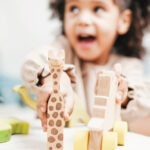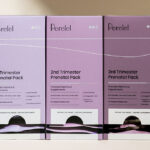Feather your nest
Admit it: Ever since you learned you were expecting, you’ve […]
Admit it: Ever since you learned you were expecting, you’ve been stockpiling bodysuits, loading up on diapers, and stashing away more baby wipes than a daycare uses in a year. Sure that little bundle of joy may be small, but her stuff is starting to take up a lot of space—and she hasn’t even gotten here yet!
Before your due date arrives, it pays to spend some time getting your home and life in order to ensure a smooth transition into motherhood. Our experts share their dos and don’ts for organizing baby gear, setting up shop, and getting a handle on all those hospital forms and important documents. So, grab a comfy chair (after you find another spot for that box of diapers), put your feet up, and read on …
Know your style
Long before you go into labor, take a look around your home and envision what life with a new baby might look like. We’re not talking about those serene moments when you’re snuggled up together during feeding time, happily rocking away. Instead, picture a scene around 3 a.m. after you’ve awoken to your newborn’s cries and stumbled into the nursery to find that she has soaked through her sleeper and is ready for a bottle. It’s moments like these when you’ll appreciate having mapped out a plan of where everything should be—including your baby.
Making space to accommodate a new person may mean changing your home’s existing layout. Perhaps the office next to your bedroom makes more sense as the nursery than the guest room down the hall. “Ask yourself how close your bedroom is to the room you plan on using for the nursery,” says Julie McCaffrey of BabyNav Baby Planners. “Is the nursery close enough that you won’t mind walking over there for each diaper changing and feeding during the night?”
Alternatively, if you’re living in close quarters, you might be sharing a room with your little one for the time being. Less space means cutting down on any unnecessary gear, and making your intentions clear to family, friends and any gift givers. “In reality, babies ‘need’ very little,” says Barbara Reich, author of Secrets of an Organized Mom. “Don’t be shy about asking family and friends for specific things, or else you will end up with oversized toys and stuffed animals that are useless.”
Having a nursery that gives you easy access to the essentials is a major advantage. But be realistic about what items you can and can’t fit, especially if your baby’s room isn’t the size of the Taj Mahal. “Today’s parents don’t skimp when it comes to their prized bundles of joy,” say Pam Ginocchio and Melisa Fluhr, co-founders of Project Nursery, an interior design firm specializing in babies’ rooms. “We always remind parents to invest in great items they love and to not to go overboard on extra stuff that will just junk up the house.”
Instead, think about whether you have storage for all the new gear you’ll be bringing into your home. If you’re planning on using a carrier, bouncy seat and/or stroller, consider where those items will be stored—the nursery? mudroom? hall closet? “It’s also a good idea to go around the house cleaning out closets and decluttering spaces to make a little extra room for baby’s things,” add Ginocchio and Fluhr.
Not to be overlooked, safety is another paramount concern when prepping your home. Double-check that you have sufficient carbon monoxide detectors and smoke alarms, and figure out whether your baby’s room will need a fresh coat of paint (to remedy flaking, chipping walls). “Ensuring parents have a clean and safe environment is a necessary first step in setting up their home for a new baby’s arrival,” says McCaffrey.
Keeping it together
Once your house is in order and you’re ready for the onslaught of shower gifts and other gear from your registry, your once-organized home may suddenly morph into a disaster zone. To avoid clutter chaos, consider investing in multitasking baby products that can do double duty to maximize your space. McCaffrey suggests a dresser that can serve as a changing table or a swing that converts to a bouncer. “Skip crib bumpers and blankets, and register for storage items that coordinate with your nursery bedding,” she adds. Collapsible products that can be folded up and stowed away, like slim highchairs and bathtubs, are also a plus.
Because even basic baby goods can add up, beware of bulk buying. “Buy what you need and only stock up on those items that you use frequently, like diapers and wipes,” cautions Reich. “I also believe in avoiding large toys that can’t be put away on a shelf or in a closet at the end of the day.”
And don’t forget to tap into your network of mom friends whose kids may have outgrown their bassinet or who might be willing to lend you their play yard when you’re headed to grandma’s. “When you can borrow these items, they don’t have to take up permanent storage space in your house,” notes Reich.
Spot on
A wise man once said, “A place for everything and everything in its place,” and the same is true for baby gear that threatens to overrun a home. Once you’ve figured out what gear to have on hand, designate certain areas in the home for certain purposes. If your house is multilevel, set up a secondary changing station stocked with diapers and wipes, suggest Ginocchio and Fluhr. “It saves you from hauling up and down the stairs all day,” they explain.
Reich seconds the advantage of setting up an additional makeshift changing station, albeit a less formal, downgraded version. “When my twins were babies, I kept diapers, wipes and lotion on each floor of my home,” she recalls. “Yet I only had one changing table, which was in the babies’ room.” Not having to run up and down the stairs multiple times a day is a big deal for the sleep-deprived parent.
In the kitchen, empty out one easy-to-reach cabinet and stock it with breastfeeding supplies and bottles. “Later on, you can swap that out for sippy cups and baby food jars,” notes McCaffrey. The same goes for the bathroom, says Reich—a shelf for baby shampoo, baby wash and hooded towels, along with a designated spot in your medicine cabinet for a thermometer and infant drops—and the family room or den where you can keep a small basket of books and toys on hand.
In your home office or wherever you keep important documents, your baby’s records need not assume their own space, but be integrated in your family files. For social security cards, birth certificates and other official documents, McCaffrey suggests a fireproof safe or safety deposit box. Medical records can be stored in an extra folder in an existing file cabinet, or you can create a three-ring binder with plastic sleeves that you can add to over the years.
When it comes to stocking your diaper bag, both the Project Nursery team and McCaffrey believe in maintaining one bag for daycare/sitter or daily outings and a second one that can be left in your car. For the larger tote that will be used more frequently, make a point of replenishing your supply of diapers, wipes and other everyday basics. And if your little one will be spending her days in the care of someone other than you, it pays to pack her favorite lovey or soothing item. “Don’t forget to keep a few plastic bags and an extra set of clothes in each bag for surprising ‘accidents,’” add Ginocchio and Fluhr.
Potential pitfalls
Of course, even with advance planning, something is bound to go awry when getting ready for your baby’s arrival. More times than not, however, mishaps can be avoided when you take our experts’ advice into consideration. Are you admittedly bowled over by those adorable footed pj’s … so much that you bought a pair in every size for your baby’s first year? You’re not alone. “Many parents love to buy new baby clothes, but it is easy to get overwhelmed by the number of clothes and how quickly sizes can change,” shares McCaffrey. Set up a simple system so you don’t end up with clothing that doesn’t fit, along with a mounting pile for donation. She suggests washing the first two to three sizes and hanging them in your baby’s closet arranged by size. Keep a separate bin for anything that no longer fits for a quick disposal spot that, when filled, can go right out for donation (or storage, if you’re planning on adding more to your clan).
When arranging your home for your new baby, don’t forget to take into account yours and your caregivers’ comfort and personal needs. “If mom is nursing, is there a comfortable chair to feed with a side table for easy access to everything she needs?” asks McCaffrey. “Is everything needed for a diaper change within arm’s reach at each changing station? Are all storage bins and baskets clearly labeled for easy cleanup?” (Remember the earlier-mentioned 3 a.m. diaper changing nightmare? No one wants to drive themselves mad trying to find a clean diaper in the wee hours of the morning.)
Speaking of your own needs, try to get the nursery ready to go before your pregnancy draws to a close. “Don’t leave the heavy lifting and painting to the last minute,” caution Ginocchio and Fluhr. “Nothing gets a pregnant mom more stressed out than a nursery that is still the old guest room or office.” If you’re set on handling the nitty-gritty design work yourself, be realistic about what—and when—you can manage it.
Stenciling a border with every letter of the alphabet may not be as appealing when your expanding baby bump is keeping you off your feet. Don’t chide yourself, and enlist your partner or a good friend for those tough-to-reach spots or for the entire project.
Have your heart set on that adorable sleigh crib and matching armoire? Don’t drag your feet on placing an order. “Many key nursery furnishings have a six- to eight-week delivery time,” note Ginocchio and Fluhr. And if an item won’t be arriving until the ninth hour, make arrangements to have it assembled before you need it. Bouncy seats, swings, a changing table and a bassinet will all be put to good use once baby arrives; a crib, highchair and activity center won’t be necessary for at least a couple of months. Cut yourself some slack, and hold off on unboxing them until your little one can take advantage.
Another common mistake is buying something because it looks or sounds great before trying it out for yourself. (You wouldn’t buy a car without first going for a test drive, right?) “Don’t just listen to friends’ and neighbors’ opinions about what you’re ‘supposed to have’ without doing your own research,” says Reich. “You may not need the same things they swear by.” If possible, check out a product in person and be sure a salesperson can demonstrate it for you. Better yet, ask him if you can fold up that stroller for yourself; after all, you’re the one who’s going to be schlepping it to the park. Try it out a few times until you can get the hang of it.
Within a few weeks after baby arrives, you’ll have a pretty good idea of which systems are working and which need a little work. Maybe the table next to your nursing chair is too small to accommodate your water bottle, nursing pads, nipple balm, burp clothes and smartphone. Or maybe you’re taking the stroller out the front door most often, so storing it by the back door doesn’t make sense. Don’t be afraid to do a little tweaking until everything feels just right. As baby grows and your needs change, so too will the way the household runs. But if you keep on top of it as best you can and evolve your routines as needed, you may find you’re spending more moments gazing serenely—and fewer shuffling around in a harried state in the middle of the night—than you’d imagined.








